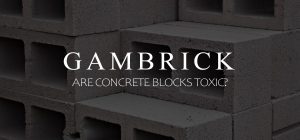
What Paint To Use On Concrete Steps
I’ve been a mason for over 25 years and can tell you firsthand that painting concrete steps is a lot different than other materials like wood, plastic, drywall or metal. It’s naturally porous and absorbs water like a sponge. The paint needs to be specially formulated to allow moisture evaporation or it will peel. Concrete is also great at absorbing heat, which means it will expand and contract. So the paint will also have to be flexible enough to move with the concrete. The best paint to use on concrete steps is called elastomeric, and is specially formulated for masonry use. Make sure when you buy your paint that it specifically states for use on concrete and is elastomeric. This will ensure proper evaporation, coverage and flexibility.
Once you have the right paint for your concrete steps picked out, you’ll need to buy the right tools followed by some prep work.
When painting concrete steps, you need high quality nap rollers thick enough to penetrate into the concrete’s pores. You’ll also need tough nylon brushes that won’t get chewed up by the concrete’s gritty texture.
Concrete steps must be very clean, free of debris, dirt, mold, sealants, flaking paint, mildew and gunk before applying paint, primer, or concrete stain.
Old paint may also need removal but it depends on the type of paint you used. Make any necessary repairs before painting and fill all the gaps and cracks with cement or masonry caulk.
Priming the concrete before you paint is an essential that I highly recommend. It makes painting easier by creating a smoother protective surface for the paint to sit on and adhere to.
The Best Outdoor Paint
Concrete steps face a lot of wear and tear over time. Especially if you live in a cold climate that sees a regular freeze/thaw cycle. A fresh coat of paint not only looks great but can also protect the concrete from weather damage. Paint and primer sit on top of the concrete’s surface and seal it. If water can’t penetrate and absorb into the concrete, then it can’t freeze and cause cracks.
The best paint and primer for concrete steps also conceals discolorations and stains. They can really transform the look of the house by covering up deep stains that won’t come out.
Not every type of paint is suitable for use on concrete steps. The best paints for concrete contain flexible binders. They contract and expand with concrete as it cools and warms. They also allow moisture inside the concrete to evaporate out which helps prevent peeling.
- Concrete step paints are usually low luster acrylic latex paints designed to conceal imperfections and resist fading, peeling, cracking and UV damage. These are great for the sides and front of the steps.
- Epoxy based paints provide higher durability and stain resistance which makes them great for the floor or step portion of the steps.
- Masonry paints are designed for brick and other masonry applications, but also provide effective coatings for concrete.
Pro Tip: Don’t use exterior house paints on concrete steps or any type of paint that’s not specifically designer for concrete. It will most likely crack, chip and peel.
Safety: Fumes are a problem whenever you paint but concrete paint and primer can be especially strong. Take the appropriate safety measures whenever you work with them.
What Paint To Use On Different Parts Of The Steps
Selecting the right type of concrete paint to use on your steps involves thinking about how much wear and tear the surface will see. The sides and front of the steps generally see a lot less wear than the top because that’s what gets walked, rained and snowed on. Planters go on the top surface and it also gets the most sun which means more UV damage. It makes sense to use a more durable paint here and a more general concrete paint on the sides and front.
Below we’ll look at each part of the concrete steps and which paints tend to work best.
General Masonry Paints
Masonry paints are designed for use on brick, stone and other masonry applications, but most are also great for use on concrete. Make sure the label says elastomeric or has the following characteristics.
A general use masonry paint will typically work on all your concrete step surfaces. It’s an all around paint that has a good amount of durability, elasticity and can breath. They’re also resistant to general wear and tear, UV damage and will resist cracking, peeling and fading.
- Masonry paints contain binders and epoxies that bond well with concrete’s pores and texture.
- Waterproofing masonry paints can be suitable for painting concrete steps.
- They need to be flexible to allow for expansion and contraction.
- Concrete paints should breath so that moisture can evaporate out of the concrete.
- Many whitewash paints are also great for use on concrete.
Side And Front Of The Steps
Acrylic latex paints are a slight upgrade from most general use masonry paint.
They’re great for the sides and front of your concrete steps. Acrylic paints can be used on the top of the steps too but they’re not as durable as an epoxy. That’s why I usually use two types of paints for my steps.
I usually use two type of colors and finishes too. White is great for the sides and front of the steps with a darker grey or brown for the top. I use a flat on the sides and front with an eggshell on the tops. I like a little sheen to give my flat areas a slight wet look.
- Low luster acrylic latex paint is designed for use on concrete. It has a high durability that resists peeling, fading and other damage while hiding imperfections.
- The best concrete paint for steps will include an enamel finish that resists mold and mildew growth. It should maintain a beautiful appearance despite wet or humid conditions.
- Expect 1-gallon of acrylic latex masonry paint to cover around 400 square feet.
Top Of The Concrete Steps
For the top of the steps that regularly get foot traffic, rain, ice, snow, dirt, etc, I use a high-performance, epoxy-based floor paint. They’re more durable than regular concrete paint and can resist more wear and tear. They’re also great if you put out planters because they’re easier to scrub clean and resist staining.
- The best paints for concrete steps have a finish designed to be highly resistant to damage, scratches, fading, dirt, mold, mildew, stains and other common issues associated with higher traffic areas. They can reduce the need for maintenance do to general wear and tear.
- The durable finish of epoxy paint resists scuffs, fading, cracking, peeling and chipping which makes it ideal for steps.
- Epoxy-based floor paint can be more expensive than other types of concrete paint and offers fewer color options. It’s usually not a problem though because most floors are painted grey or an earthy color.
- Expect 1-gallon of epoxy floor paint to cover approximately 300 to 500 square feet.
Concrete Restoration Paints
If your concrete steps have developed small cracks, a concrete restoration paint can help. They’re not designed to repair large cracks but small ones can be covered up by the paint.
Larger cracks should be filled with cement or masonry caulk prior to paint. Really large cracks may need sections of the concrete to be demolished and rebuilt. It all depends on the size and nature of the cracks. But having a simple paint that can restore small cracked concrete surfaces is a big plus.
- Concrete restorers can be up to 10 times thicker than regular paint. They can fill cracks up to 1/4 inch thick.
- Restorers provide excellent slip resistance and are durable.
- Each new application lasts up to 12 years.
- They offer lasting protection against moisture build up.
- Expect 1-gallon of restorer to cover around 100 square feet.
- Apply concrete restoration paint just like regular paints.
Pro Tip: Make sure you choose a restorer that says for use on concrete. Concrete restorers will not work on wood decks, and wood restorers will not work on concrete. They make restoration paints for different surfaces so it can be confusing.
Application & Care Of Concrete Paint
The best concrete paint jobs include careful preparation and concrete repair prior to painting.
- Sand off any gunk or uneven areas on the concrete floor. Hardened residue may need to be scraped off.
- Use a de-greasing cleaner and a scrub brush with water to remove any dirt and/or grease from the concrete steps.
- Allow the concrete to completely dry, then vacuum any leftover debris and residue off the steps.
- Fill in all the cracks, gaps and holes with cement or masonry caulk.
- Large damaged areas may need to be demolished re-built.
- Allow repairs to dry completely.
- Begin applying concrete primer with a paint brush. Start on the corners and edges of the concrete steps and then work inward.
- Use a paint roller to apply primer on large flat areas. Two coats of primer are recommended for best results.
- Allow the primer to dry for at least two hours after each coat.
- Repeat the same method above to paint the concrete steps.
- If you’re sealing the concrete after painting, apply sealer in the same way as primer and paint. Allow it to dry between coats.
- When the surface begins to look worn over time, clean it with soap and water. Let the soap sit for 20 to 30 minutes, then rinse off with a hose. Only try harsher cleaners if the soap doesn’t work.
Safety: Always use a paint respirator mask when sanding or using concrete paint. Especially if your not working in a well ventilated area. I’d also recommend wearing safety glasses.
How To Paint Concrete Steps Step By Step
Here’s a simple step by step rundown of how you should paint your concrete steps. Remember, preparation and use the right type of paint are the keys to success.
Concrete paint not only looks great but also helps seal and protect the concrete from future damage.
Repair The Concrete Steps
The first thing you need to do is repair the steps. If you find medium to large cracks they all need to be filled. Small hairline cracks can usually be filled with primer and concrete paint.
Use cement or masonry caulk to fill the cracks. I prefer cement because it better matches the surface of the concrete steps. You’ll be able to see the difference between concrete and caulk but cement is better at blending in.
You can also use cement caulk. It’s basically premixed cement in a tube. It’s not as good as mixing your own cement because you can’t vary the texture but it still works.
Make sure if you use caulk that it’s masonry caulk and not regular household caulk. Masonry products are flexible and can expand and contract with the concrete.
Pro Tip: If you’re using caulk, cement caulk or even mixing your own cement, have some gritty sand on hand. I like to mix some into my repairs to play with the texture. The more I can make the repair look like the original concrete surface the better. I don’t want my repairs to be visible once I apply the paint and primer.
Clean the Concrete
Cleaning the concrete steps is a very important step because concrete tends to trap in lots of dirt, grease, grime, mold, mildew, etc. It’s very porous so the dirt just soaks right in with the water. If you paint a dirty surface, you’ll lock those substances in.
Remove dirt and grease with regular soap and water first. Scrub the concrete with a medium to hard brush. You could also try a power washer. Vary the pressure based on the condition of your steps. Too much power can actually damage old concrete.
If that doesn’t work try a cleaner like trisodium phosphate. If you’re like me and would rather use a more natural cleanser they’re are a few on the market. They’re not a strong but work on most stains. I usually use chemicals as an absolute last resort once I’ve tried everything else.
Pull off vines and moss growing on the foundation. Use a pressure washer or knife to help. Make sure you don’t just pull them off hard because they make have worked they’re way into the concrete. You could end up pulling off a chuck of step.
Remove efflorescence. It’s that a white powder that forms on concrete and other masonry structures.
Even if your concrete steps are brand new you should still clean them off before painting. There could be dust, dirt or pollen on the surface which you’ll want to remove. If you don’t it will all get mixed in with the paint.
Strip Old Paint
Strip as much of the old paint as you can. Some old paint can be painted over so you may not have to remove all of it. But whatever you see that’s chipped, peeling, cracked, etc.
You don’t want to paint over damaged old paint because that damage will transfer to the new paint job. It’s just like painting a car. If the old paint is still good you can sand off the clear coat and re-paint. There’s usually no need to completely strip the car. But if the paint is damaged that area will have to be fixed before re-painting.
Prime the Concrete
Concrete primer, called block primer, fills pores and evens out the surface. It creates a nice smooth surface for the new paint to adhere too. It also fills in lots of small cracks and textured surfaces. Paint jobs typically come out much better when a primer is used first.
Primers are also better at covering up stains. This is especially helpful if your painting those old concrete steps white.
A concrete primer is usually cheaper than a good quality masonry paint. Use the cheaper primer first to cover up stains and the good stuff later. Taking this extra step can save you money.
Paint the Concrete
Masonry paint, also called elastomeric paint, is a good choice for concrete steps because it contains binders that contract and expand with the concrete. Other types of paint can crack and peel on concrete.
Make sure the concrete is very dry before you paint. Even though masonry paint can breath you don’t want to overdo it by locking in lots of moisture. It’s best to paint concrete steps on a very dry day.
Concrete is great at absorbing lots of heat too so make sure the surface is around 55 – 80 degrees. Not too hot or too cold. Unless you have a heat gun just give it a touch test. If it’s too hot or too cold to press your hand on comfortably then it’s probably not ready to paint.
Apply the paint with a brush long the edges and corners first. Then use a roller for the larger areas. You may also want to mask off areas you don’t want paint with some painters tape.
If you want to use a sprayer make sure it’s not too thick for your nozzle or it’ll get clogged quick.
No matter how you apply the concrete paint, let it dry completely between coats. You’ll probably need two to four coats or paint and primer so check the weather forecast before you stat painting.
I usually do one to two coats of primer and then one to two coats of paint.
The Finish Coat
Not all concrete paint jobs need a finish coat. But if you decide to use one then apply it at the very end once the paint has fully dried. It’s very common to use a finish coat on top of colors or stamped concrete. You can vary the sheen to create a nice wet look.
I recommend varying the sheen just like you would the steps in your house. Typically we use a glossier finish on a wood step then we do on the stair paint. This not only makes the step look nicer but also creates some visual contrast. The eye is drawn to the step because of that subtle egg shell sheen. I wouldn’t go too shiny. But a semi gloss or egg shell looks nice on a concrete step.
I stick with flat or a very subtle sheen on the sides and front of the steps. A finish coat adds an additional layer of protection for the paint which makes it easier to clean. If you’ve ever had flat wall paint you’ll know what I mean. Everything seams to stain them and they’re hard to wash clean. because your scrubbing bare paint.
Make sure you buy a finish that’s meany for concrete or masonry products. Again, the finish needs to be flexible and breath.
Concrete paint finishes can also be textured or have UV protection. This can help prevent the paint from fading and make concrete steps less slippery. The texture gives concrete a sandpaper feel.
Does The Type Of Concrete Matter?
Yes and no. Manufacturers don’t make different types of concrete paint for different types of concrete. it’s kind of a one size fits all paint. However, you can choose a different paint that better suits your type of concrete.
If you’ve got very smooth concrete that’s dense and like brand new. You wouldn’t need an overly thick concrete paint. Concrete restoration paint are out and you won’t likely need repairs.
If you’ve got older concrete that’s heavily porous, cracked or textured, you may need a thicker concrete paint.
Some concrete has lots of visible stones in it. If you like the texture then a thin concrete will preserve it. However, if you want to even the surface out a thicker paint can help.
Old vs new concrete doesn’t matter much except older concrete will most likely need more repairs. It’ll probably need a more thorough cleaning too. Just make sure to do it all before painting.
The psi of your concrete generally has no effect on the paint. However, be careful how you clean and repair old and brittle concrete. Match the psi of your new work to the old. If your new concrete or cement repairs are too dense for the old work you could create additional cracks.
What About Painting Concrete Steps With Other Materials?
This is a very common problem we encounter. Concrete steps mixed with stone, limestone, pavers, cultured stone, stucco or brick. Luckily the same basic methods used to paint concrete also apply to other types of masonry. And the paints are generally the same too.
I would recommend doing a little bit of additional research based on the 2nd material your working with before painting. But generally speaking everything we’ve discussed here will also work on other masonry products.
The one issue that may cause you some problems is when wood is involved. If you’ve got concrete steps with some wood, you’ll have to use two types of paint. Concrete paint is for concrete and wood paint is for wood. You shouldn’t mix and match them.
Tips
Here are a few more tips to help you paint your concrete steps.
- Don’t underestimate how porous concrete is. It can soak up paint like a sponge. Make sure to buy more paint then you think you’ll need and use a good primer first. It’s cheaper than paint and can save you money.
- Concrete can be slick when it gets wet. This is one of the few flaws with concrete surfaces and can be especially problematic with stairs. Luckily you can help fix this with paint. Mix a nonskid floor finish into your paint. It’ll give the stairs the grittiness of sandpaper.
- Don’t use really expensive brushes on concrete. It’s a rough hard surface which can damage fine bristles. The same Purdy brush we use on fine trim work isn’t what we use painting concrete steps. Get something cheaper but still a decent quality so hairs aren’t left all over the concrete. Synthetic fibers work really well here.
- I like to use Frog Tape. It leaves a cleaner line when peeled off. Even though we’re painting concrete I still want to do a nice job. And I like to use different color/type of concrete paint for the front, sides and surface. This means I’ll need some tape to get a cleaner line.
Summary: What Paint To Use On Concrete Steps
I’ve been a mason for over 25 years and can tell you firsthand that painting concrete steps is a lot different than other materials like wood, plastic, drywall or metal. It’s naturally porous and absorbs water like a sponge. The paint needs to be specially formulated to allow moisture evaporation or it will peel. Concrete is also great at absorbing heat, which means it will expand and contract. So the paint will also have to be flexible enough to move with the concrete. The best paint to use on concrete steps is called elastomeric, and is specially formulated for masonry use. Make sure when you buy your paint that it specifically states for use on concrete and is elastomeric. This will ensure proper evaporation, coverage and flexibility.
Once you have the right paint for your concrete steps picked out, you’ll need to buy the right tools followed by some prep work.
When painting concrete steps, you need high quality nap rollers thick enough to penetrate into the concrete’s pores. You’ll also need tough nylon brushes that won’t get chewed up by the concrete’s gritty texture.
Concrete steps must be very clean, free of debris, dirt, mold, sealants, flaking paint, mildew and gunk before applying paint, primer, or concrete stain.
Old paint may also need removal but it depends on the type of paint you used. Make any necessary repairs before painting and fill all the gaps and cracks with cement or masonry caulk.
Priming the concrete before you paint is an essential that I highly recommend. It makes painting easier by creating a smoother protective surface for the paint to sit on and adhere to.
If you have any questions or comments about painting concrete email any time.

John Mazzuca | About | More Posts |
Custom Home Builder
John Mazzuca is a custom home designer and builder at Gambrick with over 25 years experience in the construction industry. John has designed, built and/or remodeled hundreds of homes, small buildings, and commercial projects. He writes about business, real estate, home building, and household electronics. His work has been featured in Fox Business, Better Homes & Garden, House Beautiful, and more.



















